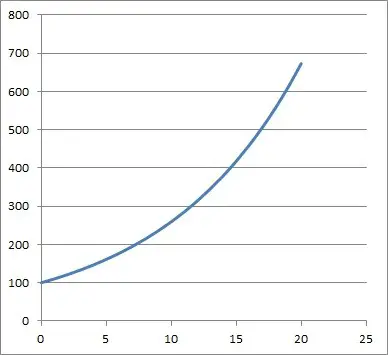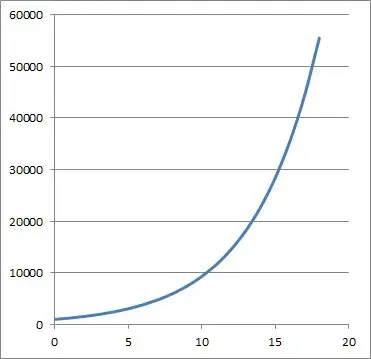Growth rates are useful in business for tracking the growth or decline of revenue, cost, profit, and other important measures. Growth rates are also useful in finance for tracking changes in the value of investments over a time period.
So, how do you calculate growth rate? To calculate growth rate, first find the starting value and ending value. Next, subtract the starting value from the ending value. Then, divide the difference by the starting value. Finally, move the decimal two places right to get a percentage growth rate.
Remember that the growth rate can be negative in some cases (when the ending value is less than the starting value). We can also calculate compound growth rates on an annual basis (or over shorter time periods).
In this article, we’ll talk about how to calculate growth rates on an annual, monthly, weekly, or daily basis. We’ll also find out how to find compound growth rates over multiple time periods.
Let’s get started.
How To Calculate Growth Rate
The 4 basic steps to calculate growth rate are as follows:
- 1. Find the starting value, S, and the ending value, E.
- 2. Take the difference E – S (subtract the starting value from the ending value).
- 3. Divide the difference from step 2 by S.
- 4. Take the number from step 2 and move the decimal point 2 places to the right (this gives us a percentage growth rate.

For a starting value of S and an ending value of E, the growth rate formula is given by:
- (Growth Rate) = (E – S) / S
We can also write this in another form by splitting the right side of the above formula into two fractions and simplifying:
- (Growth Rate) = (E / S) – (S / S)
- (Growth Rate) = (E / S) – 1
So, the alternative formula is to divide the ending value by the starting value and subtract 1.
No matter which formula we use, we need to take the result and move the decimal point two places to the right. This will give us a percentage growth rate instead of a decimal.
Let’s look at how to calculate growth rates on an annual basis.
How To Calculate Annual Growth Rate
To calculate annual growth rates, we need to make sure that the starting and ending value (S and E) are one year apart. Often, this means the starting value is from January 1 of a given year and the ending value is from December 31 of the same year.
Let’s look at some examples.
Example 1: How To Calculate Annual Growth Rate
Let’s say that a company’s stock has a price of $120 on January 1, 2022 and a price of $150 on December 31, 2022.

Since we are calculating an annual growth rate, we want the starting and ending values to be 1 year apart. In this case, they are.
This means that the starting value is S = $120, and the ending value is E = $150.
Now we will use the growth rate formula with S = $120 and E = $150:
- (Growth Rate) = (E – S) / S
- (Growth Rate) = (150 – 120) / 120
- (Growth Rate) = 30 / 120
- (Growth Rate) = 0.25
The growth rate (as a decimal) is 0.25. As our last step, we move the decimal point 2 places to the right to get a 25% annual growth rate.
Example 2: How To Calculate Annual Growth Rate
Let’s say that a house has a price of $250,000 on January 1, 2020 and a price of $150,000 on December 31, 2020.

Since we are calculating an annual growth rate, we want the starting and ending values to be 1 year apart. In this case, they are.
This means that the starting value is S = $250,000, and the ending value is E = $150,000.
Now we will use the growth rate formula with S = $250,000 and E = $150,000:
- (Growth Rate) = (E – S) / S
- (Growth Rate) = (150,000 – 250,000) / 250,000
- (Growth Rate) = -100 / 250
- (Growth Rate) = -0.4
The growth rate (as a decimal) is -0.4. As our last step, we move the decimal point 2 places to the right to get a -40% annual growth rate.
In this case, the growth rate is negative. This makes sense, since the value of the house decreased over the year in question.
How To Calculate Compound Annual Growth Rate
In some cases, we need to calculate the compound growth rate over a period of 2 or more years.

Let’s say that we track the value over N years, and it has a starting value of S, an ending value of E (N years later).
To find the compound annual growth rate, we use the following formula:
- (Annual Compound Growth Rate) = N√(E / S) – 1
or:
- (Annual Compound Growth Rate) = (E / S)1/N – 1
In other words, our steps are:
- 1. Find the starting value S and the ending value E.
- 2. Divide E by S.
- 3. Take the Nth root of the value from step 2.
- 4. Subtract 1 from the value from step 3.
- 5. Take the number from step 2 and move the decimal point 2 places to the right (this gives us a percentage growth rate.
Let’s look at some examples.
Example 1: How To Calculate Compound Annual Growth Rate
Let’s say that a company’s stock has a price of $250 on January 1, 2022 and a price of $360 on December 31, 2023.
Since we are calculating a compound annual growth rate, need to know the value of N (how many years apart the starting and ending values are). In this case, we have N = 2 (January 1, 2022 to December 31, 2023 is two years).
This means that the starting value is S = $250, and the ending value is E = $360, with N = 2.
Now we will use the compound annual growth rate formula with S = $250, E = $360, and N = 2:
- (Annual Compound Growth Rate) = N√(E / S) – 1
- (Annual Compound Growth Rate) = 2√(360 / 250) – 1
- (Annual Compound Growth Rate) = 2√(36 / 25) – 1
- (Annual Compound Growth Rate) = (6 / 5) – 1
- (Annual Compound Growth Rate) = 1.2 – 1
- (Annual Compound Growth Rate) = 0.2
The growth rate (as a decimal) is 0.2. As our last step, we move the decimal point 2 places to the right to get a 20% compound annual growth rate.
We can check our work as follows:
- The starting value of S = $250 increases by 20% (+$50) to $300 by the end of year 1.
- The value of $300 increases by 20% (+ $60) to the ending value of E = $360 by the end of year 2.
So, the numbers check out.
Example 2: How To Calculate Compound Annual Growth Rate
Let’s say that a house has a price of $300,000 on January 1, 2022 and a price of $218,700 on December 31, 2024.
Since we are calculating a compound annual growth rate, need to know the value of N (how many years apart the starting and ending values are). In this case, we have N = 3 (January 1, 2022 to December 31, 2024 is three years).
This means that the starting value is S = $300,000 and the ending value is E = $218,700, with N = 3.
Now we will use the compound annual growth rate formula with S = $300,000, E = $218,700, and N = 3:
- (Annual Compound Growth Rate) = N√(E / S) – 1
- (Annual Compound Growth Rate) = 3√(218,700 / 300,000) – 1
- (Annual Compound Growth Rate) = 3√(729 / 1000) – 1
- (Annual Compound Growth Rate) = (9/10) – 1
- (Annual Compound Growth Rate) = 0.9 – 1
- (Annual Compound Growth Rate) = -0.1
The growth rate (as a decimal) is -0.1. As our last step, we move the decimal point 2 places to the right to get a -10% compound annual growth rate.
We can check our work as follows:
- The starting value of S = $300,000 decreases by 10% (-$30,000) to $270,000 by the end of year 1.
- The value of $270,000 decreases by 10% (-$27,000) to $243,000 by the end of year 2.
- The value of $243,000 decreases by 10% (-$24,300) to the ending value of E = $218,700 by the end of year 3.
So, the numbers check out.
How To Calculate Monthly Growth Rate
To calculate monthly growth rates, we need to make sure that the starting and ending value (S and E) are one month apart. Often, this means the starting value is from the first day of a given month and the ending value is from the last day of the same month.
Let’s look at some examples.
Example 1: How To Calculate Monthly Growth Rate
Let’s say that a company’s stock has a price of $110 on January 1, 2022 and a price of $121 on January 31, 2022.
Since we are calculating a monthly growth rate, we want the starting and ending values to be 1 month apart. In this case, they are.
This means that the starting value is S = $110, and the ending value is E = $121.
Now we will use the growth rate formula with S = $110 and E = $121:
- (Growth Rate) = (E – S) / S
- (Growth Rate) = (121 – 110) / 110
- (Growth Rate) = 11 / 110
- (Growth Rate) = 0.1
The growth rate (as a decimal) is 0.1. As our last step, we move the decimal point 2 places to the right to get a 10% annual growth rate.
Example 2: How To Calculate Monthly Growth Rate
Let’s say that a house has a price of $200,000 on January 1, 2020 and a price of $198,000 on January 31, 2020.
Since we are calculating a monthly growth rate, we want the starting and ending values to be 1 month apart. In this case, they are.
This means that the starting value is S = $200,000, and the ending value is E = $198,000.
Now we will use the growth rate formula with S = $200,000 and E = $198,000:
- (Growth Rate) = (E – S) / S
- (Growth Rate) = (198,000 – 200,000) / 200,000
- (Growth Rate) = -2,000 / 200,000
- (Growth Rate) = -0.01
The growth rate (as a decimal) is -0.01. As our last step, we move the decimal point 2 places to the right to get a -1% annual growth rate.
In this case, the growth rate is negative. This makes sense, since the value of the house decreased over the year in question.
How To Calculate Compound Monthly Growth Rate
In some cases, we need to calculate the compound growth rate over a period of 2 or more months.
Let’s say that we track the value over N months, and it has a starting value of S, an ending value of E (N years later).
To find the compound monthly growth rate, we use the following formula:
- (Monthly Compound Growth Rate) = N√(E / S) – 1
or:
- (Monthly Compound Growth Rate) = (E / S)1/N – 1
In other words, our steps are:
- 1. Find the starting value S and the ending value E.
- 2. Divide E by S.
- 3. Take the Nth root of the value from step 2.
- 4. Subtract 1 from the value from step 3.
- 5. Take the number from step 2 and move the decimal point 2 places to the right (this gives us a percentage growth rate.
Let’s look at some examples.
Example 1: How To Calculate Compound Monthly Growth Rate
Let’s say that a company’s stock has a price of $300 on January 1, 2022 and a price of $363 on February 28, 2022.
Since we are calculating a compound monthly growth rate, need to know the value of N (how many months apart the starting and ending values are). In this case, we have N = 2 (January 1, 2022 to February 28, 2022 is two months).
This means that the starting value is S = $300, and the ending value is E = $363, with N = 2.
Now we will use the compound annual growth rate formula with S = $300, E = $363, and N = 2:
- (Monthly Compound Growth Rate) = N√(E / S) – 1
- (Monthly Compound Growth Rate) = 2√(363 / 300) – 1
- (Monthly Compound Growth Rate) = 2√(121 / 100) – 1
- (Monthly Compound Growth Rate) = (11 / 10) – 1
- (Monthly Compound Growth Rate) = 1.1 – 1
- (Monthly Compound Growth Rate) = 0.1
The growth rate (as a decimal) is 0.1. As our last step, we move the decimal point 2 places to the right to get a 10% compound monthly growth rate.
We can check our work as follows:
- The starting value of S = $300 increases by 10% (+$30) to $330 by the end of January.
- The value of $330 increases by 10% (+ $33) to the ending value of E = $363 by the end of February.
So, the numbers check out.
Example 2: How To Calculate Compound Monthly Growth Rate
Let’s say that a house has a price of $3,000,000 on January 1, 2022 and a price of $3,183,624 on March 31, 2022.
Since we are calculating a compound monthly growth rate, need to know the value of N (how many months apart the starting and ending values are). In this case, we have N = 3 (January 1, 2022 to March 31, 2022 is three months).
This means that the starting value is S = $3,000,000 and the ending value is E = $3,183,624, with N = 3.
Now we will use the compound Monthly growth rate formula with S = $3,000,000, E = $3,183,624, and N = 3:
- (Monthly Compound Growth Rate) = N√(E / S) – 1
- (Monthly Compound Growth Rate) = 3√(3,183,624 / 3,000,000) – 1
- (Monthly Compound Growth Rate) = 3√(1,061,208 / 1,000,000) – 1
- (Monthly Compound Growth Rate) = (102/100) – 1
- (Monthly Compound Growth Rate) = 1.02 – 1
- (Monthly Compound Growth Rate) = 0.02
The growth rate (as a decimal) is 0.02. As our last step, we move the decimal point 2 places to the right to get a 2% compound monthly growth rate.
We can check our work as follows:
- The starting value of S = $3,000,000 increases by 2% (-$60,000) to $3,060,000 by the end of January.
- The value of $3,060,000 increases by 2% (+$61,200) to $3,121,200 by the end of February.
- The value of $3,121,200 increases by 2% (+$62,424) to the ending value of E = $3,183,624 by the end of March.
So, the numbers check out.
Conclusion
Now you know how to calculate growth rates on an annual or monthly basis. You also know how to calculate annual or monthly compound growth rates over multiple time periods.
I hope you found this article helpful. If so, please share it with someone who can use the information.
Don’t forget to subscribe to my YouTube channel & get updates on new math videos!
~Jonathon

